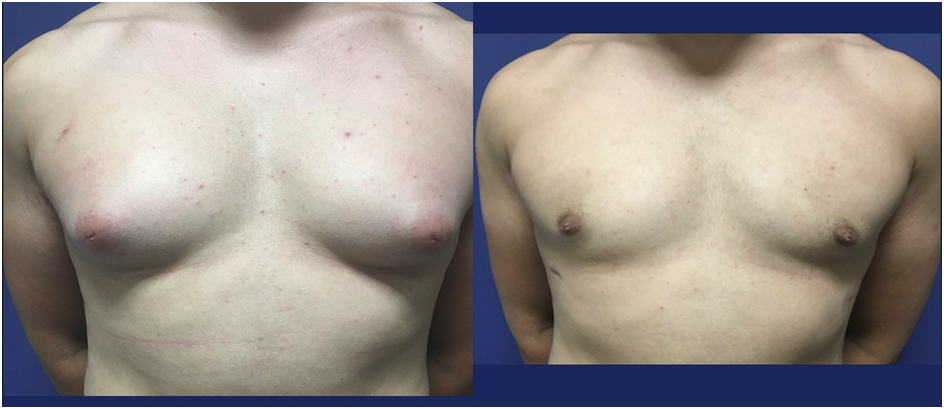Gynaecomastia Surgery: A Comprehensive Guide
Introduction
Gynaecomastia is a condition characterized by enlarged breasts in men. It is a common condition, affecting up to 60% of men at some point in their lives – mostly during puberty. The vast majority of cases of gynaecomastia which develop during puberty have resolved completely by 16 years of age. However, in some young men the gynaecomastia continues, causing distress and social embarrassment. Gynaecomastia can be caused by a variety of factors in addition to puberty, including hormonal changes, certain medications, and genetic predisposition. The most common medications that cause gynaecomastia are anabolic steroids, marijuana (THC) and some diuretics. The gynaecomastia that results from these medications doesn’t always resolve when intake is ceased.
Gynaecomastia surgery, also known as male breast reduction, is a surgical procedure that removes excess breast tissue and fat from men. It is an effective way to remove extra tissue underneath the nipple. This may also reduce the discomfort associated with enlarged breasts.
Types of Gynaecomastia Surgery
There are different types of Gynaecomastia surgery:
- Liposuction: This is the most common type of Gynaecomastia surgery. It involves removing excess fat from the breasts using a suction device.
- Subcutaneous mastectomy: This type of Gynaecomastia surgery involves removing excess breast tissue and fat through incisions around the areola or in the crease under the breast.
- Power assisted Liposuction with gland avulsion: this is a hybrid technique and the one favoured by A/Prof Damian Marucci. Liposuction via a small incision in the armpit is combined with a direct removal of gland tissue through this same small incision. The technique is described in detail below
Benefits of Gynaecomastia Surgery
Gynaecomastia surgery can offer a number of benefits, including:
- Reduced breast size and contour
- Relief from discomfort associated with enlarged breasts (such as pain, chafing, and difficulty fitting clothing)
- Improved self-confidence and body image
Who is a Good Candidate for Gynaecomastia Surgery?
Gynaecomastia surgery is a good candidate for men who:
- Are in good overall health
- Have realistic expectations about the outcome of the procedure
- Are bothered by the appearance of their enlarged breasts
- Have stable breast size and shape
- Have ceased any medications/ drugs that may contribute to the development of gynaecomastia
Gynaecomastia Surgery – Before and After Photos
Here are some before and after photos of one of A/Prof Damian Marucci’s previous gynaecomastia correction patients.
You can see more before and after photos of A/Prof Marucci’s results by clicking here.
What to Expect Before, During, and After Gynaecomastia Surgery
Before Gynaecomastia Surgery
During the consultation with A/Prof Marucci, he will take a full medical history from you, in particular any history of surgery, allergies, medications, smoking and alcohol intake and any family history of gynaecomastia or breast cancer. A/Prof Marucci will then perform a standard examination of your chest including the glands in the armpits, to make sure there are no suspicious masses that might need further investigation. A/Prof Marucci will then analyse the shape of your chest, the symmetry and the relative position of the nipple to the fold underneath the breast. A/Prof Marucci will discuss your goals for the procedure and the risks and benefits of gynaecomastia surgery. A/Prof Marucci will show you before and after photos of previous patients he has treated. Often two consultations are undertaken before surgery. After a thorough explanation of the potential risks and complications, A/Prof Marucci will take you through the consent form and a full written outline of the costs involved will be provided.
During Gynaecomastia Surgery
- On the day of the surgery, A/Prof Marucci will first draw on you to make a plan for the surgery
- You will be taken into the operating theatre and the anaesthetist will make you go to sleep by giving you medicine through a drip
- A/Prof Marucci will then put local anaesthetic solution into the tissues of the chest. A 1.5 – 2.5 cm incision is then made in the armpit. Liposuction is performed through thin hollow tubes to remove fat. Through the same incision, the excess glandular tissue underneath the nipple is removed and sent to the lab for analysis. The incision is then closed with dissolving sutures. Dressings are placed on the wounds
- A chest binder is then put on – this is like a stretchy corset that does up with Velcro in front of the chest. The chest binder applies gentle pressure to the chest area to prevent the build-up of fluid
After Gynaecomastia Surgery
- You will go home on the day of the surgery. Take it easy when you get home. Leave the dressings alone. You can remove the chest binder the day after the surgery and shower normally using soap and shampoo. The dressings on the wounds can get wet the day after surgery. Pat the dressings dry after your shower and then put the binder back on
- The local anaesthetic will last for a few hours. You will be given painkillers to go home with
- You need to wear the binder day and night for the first 3 weeks, and then just at night for another 3 weeks.
- If there is any bleeding from the wound, put firm pressure on the bleeding area for at least 10 minutes with clean tissues. This should stop 99% of all bleeding. Look at the clock and make sure it is a full 10 minutes. If the bleeding hasn’t stopped after 20 – 30 minutes of pressure, let the rooms or A/Prof Marucci know
Risks and Complications of Gynaecomastia Surgery
Gynaecomastia surgery is a safe procedure, but there are some risks and complications associated with it, including:
- Bleeding
- Infection
- Scarring
- Changes in nipple sensation
- Unsatisfactory results
For a more complete A-Z list of the potential complications ofprocedures like gynaecomastia surgery, click here.
Recovery from Gynaecomastia Surgery
Most people are able to return to work or school within a few days of Gynaecomastia surgery. However, it may take several weeks for your chest to fully heal. During this time, it is important to avoid strenuous activity and protect your chest from the sun.
Finding a Qualified Gynaecomastia Surgeon
It is important to choose a qualified and experienced surgeon for your Gynaecomastia surgery procedure. Look for a surgeon who is a Fellow of the Royal Australasian College of Surgeons (FRACS) and is a member of the Australian Society of Plastic Surgeons (ASPS) as well as the Australasian Society of Aesthetic Plastic Surgeons (ASAPS). A/Prof Marucci has a FRACS in Plastic and Reconstructive Surgery. He is on the Education Committee of ASPS and is on the Board of ASAPS. A/Prof Marucci is registered a specialist in Plastic and Reconstructive surgery with AHPRA.
Conclusion
Gynaecomastia surgery can be an effective way to improve the appearance of your chest and reduce discomfort associated with enlarged breasts. If you are considering Gynaecomastia surgery, be sure to consult with a qualified experienced surgeon like A/Prof Damian Marucci to discuss your goals and expectations.

